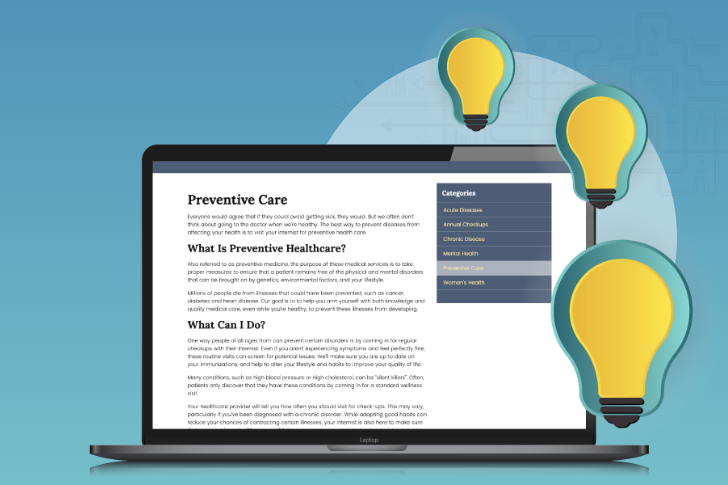4 Easy Steps to Resurrect Your Social Media Presence
By: Angelina Bice
Time to face facts: the worst has happened. Your social media presence is cold in the ground. So what happens now?
You had good intentions, didn’t you? You knew your practice was supposed to be on Facebook and Twitter, so you made sure you were represented on both, a great first step. But then you walked away, assuming that being on social media was the same as being engaged on social media.
Put yourself in the shoes of a potential patient who seeks you out on Facebook or Twitter. If you were to pull up a Twitter profile and see that it hadn’t been updated in the last six months, you wouldn’t stick around. At best you would click away, assuming the account was abandoned. At worst, you might think the practice was too lazy to post, had nothing interesting to say, or lagged so far behind on social media that they just didn’t care. Having a sparse or dead social media account is only a half step above having one at all – and, in some ways, it reflects more negatively on your practice.
A polished social media presence is a powerful tool, especially alongside a responsive website and a strong SEO program. With these elements in place, you’ll become a juggernaut of an online presence that can’t help but attract new patients. All of that potential, however, can be undone when you don’t pay attention to a few key factors.
1. Be Accurate
Before even thinking about posting, take a look at the basic information on your Facebook Business Page.
This is less important on Twitter, which only has space for your city, website, and a short bio. But Facebook provides tons of options to identify your business, and it’s important to make sure they’re always up to date. Accuracy here can be the difference between a new patient through the door and an upset prospect who tells all their friends you didn’t update your address when you moved.
For instance, have you added your office hours? If you have, your business page will tell visitors that you are ‘Open’ when they visit it during business hours. Don’t risk someone turning up at your office on a Friday when you’re closed!
Is the listed phone number still correct? Is there a better number you could direct them to? Has your website address changed?
While this may all seem painfully basic, this crucial information is one of the primary reasons a potential patient visits your Facebook page. They may check it on their smartphone to ensure they’re headed to the right address, or use the phone number on your page because they assume it’s the most up to date.
For a long-time patient, neglecting to update your business information can make them feel like your practice was too inconsiderate to think of their time. The next time you get a new phone line or change your hours, keep Facebook, as well as your website, at the top of your mind.
2. Post regularly
Now that your social media profiles are accurate, post, and post regularly! Keeping up a schedule is one of the best things you can do for your web presence – when new visitors see your page, they’ll see a history of activity, and followers will keep you top of mind.
Just don’t forget to strike a balance. You want to post often, but not so often that your patients unfollow you for spamming their feeds. A post or two a day is fine for Facebook. Tweets have a shorter shelf life, so you can tweet up to four or five times a day without flooding your followers.
If you stretch time between posts for too long, however, your pages look empty. Don’t go any longer than a month at most between posts on Facebook. On Twitter, where posts are shorter and the pace is faster, try to get something up at least once or twice a week.
3. Post well
While it’s become a cliche, it is still true that ‘Content is King’ in the age of the Internet. High quality content is one of the most important factors in getting new visitors to engage with you, rather than click away.
The quality of your posts is just as important as their frequency. You can post all the updates you want – if they aren’t good, they won’t be read, period. And that isn’t just about the psychology of followers. That’s about the raw numbers, too.
Facebook knows that most users would prefer to see content from friends and family first, and they now limit the amount of posts from businesses that appear in a person’s newsfeed. They have stated themselves that “of the 1,500+ stories a person might see whenever they log onto Facebook, the News Feed displays approximately 300.” How do they decide what people see and what they don’t? They say that showing more “high quality” content is part of it – you can read some of their guidelines on how exactly they define that here.
For example: you post an update about your practice. You write it quickly, and the post has grammatical errors. It’s about an inside joke between members of your practice staff, and wasn’t written with your audience in mind. It doesn’t include an image, or a link to a piece of good content. It’s bare, sloppy, and doesn’t offer value to your followers.
Because of the post’s low quality, the people following you ignore it, or flag it as something they don’t want to see. They may even unfollow your page after seeing this post. Because of this ‘negative feedback,’ Facebook’s algorithm decides fewer people will see your post. And, even worse, Facebook may now show your future posts to fewer people who follow you. While this post will always be visible for people who visit your Facebook page, posting bad content repeatedly, will lower the effectiveness of your Facebook as a whole.
Making sure all your posts are high quality can seem daunting, but it boils down to posting things that you would want to see on your own feed. Again, put yourself in the shoes of your audience.
Some examples:
- Post a photo of a stellar patient (with their permission, of course) or staff member, and talk a little about their story.
- Share a link to an article you think is educational or informative.
- Post a funny thought or image relevant to your practice.
- Specials or coupons on various services – social media is a great way to get the word out about them, and patients are more likely to follow you if they think they’ll get something in return.
- Write content yourself. This is probably the best way to update your page, especially if you speak to something your patients care about. Writing on your own blog and linking on social media is a great strategy as well, because it drives traffic from Facebook back to your website, the hub of your web presence. This can help your search engine rankings, and good-quality posts drive interest and engagement on social media. It’s a win-win!
Remember, the best Facebook posts are short. Fast Company has said that the ideal status is less than 40 characters – pretty amazing, considering that Twitter is the network with the harsh character limit, and their ideal post length is 100 characters! Many Facebook posts link off to longer content, but the text you add above the link or image should be pithy and quick.
Don’t have time to write your own content, or not sure how to present it attractively on social media? Consider working with a content marketing service that will ensure a steady flow of high-quality content to your social media profiles.
4. Represent!
With an active and engaging social presence, new patients will actually want to follow you! But how do you get patients visiting your pages in the first place?
Listing your social media profiles on your website is a great place to start, as an integrated web presence is the foundation of a strong business. But there’s another easy answer – and best of all, it’s free.
Get your employees involved. Employee advocacy is the secret sauce of a great social media campaign. Your employees see your patients every day, and it’s easy for them to kindly ask new visitors to follow the practice on Facebook and Twitter. Just this tiny moment of interaction can let a new patient know that you’re online, active, and available.
Your employees are also likely to have social media profiles of their own, and they can share your Facebook posts or Tweets to their own network of followers. This is especially helpful on Facebook because of that pesky algorithm we mentioned earlier – when your employee shares your post, their friends are more likely to see it because of their close relationship. While it doesn’t leap the hurdle of the algorithm 100% of the time, this is a simple and effective way to amplify your posts for your entire community.
Get Going
If your social media profiles are dead in the water, you owe it to your practice’s reputation and lost growth potential to get them updated. The longer they lie fallow, the more chances you’ve lost to show what makes your practice special to the millions of users on major social media sites.
Questions? Tips and tricks for staying active? Let us know in the comments!
(P.S: If you like posts like this one, get more good stuff in your feed from our Facebook, Twitter, and LinkedIn.)



